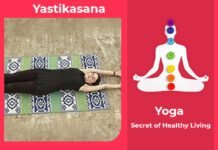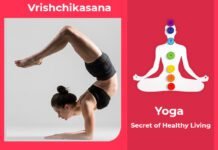What is Virasana 2
Virasana 2 Vira means brave. The way a brave man takes position while attacking his enemy, the similar position is formed in this asana, hence it is called as Virasana.
Also Know as: Hero Posture / Pose 2, Veera or Vira Asana, Veer or Vir Asan, Veerasana
How to start this Asana
- Take the left foot forward and place the left foot on the floor at the maximum distance from the initial position.
- Bring both the hands together, join the palms and place them on the knees of the left leg.
- Bend the left leg in the knee in such a way that the thigh and the calf come in 90 degrees.
- Keep the right leg straight.
- Raise the joined hands up and take them back above the head and then without bending the hands in the elbows, bend the head backward and keep the sight backward down.
How to end this Asana
- To release, start bringing the body forward and place the hands on the knee.Keep sight to the front.
- Straighten the knee and restore the hands to their original place.
- Restore the left leg to its place and take up standing position.
Video Tutorial
Benefits of Virasana 2
According to research, this Asana is helpful as per below(YR/1)
- In this asana the blood circulation to the joints of the legs, the waist, the spinal column and the neck is regulated.
- The spinal column becomes elastic and its functioning improves.
- There is pressure on the digestive organs and the belly gets stretched, which promotes their function.
Precaution to be taken before doing Virasana 2
As per several scientific studies, precautions need to be taken in diseases mentioned as per below(YR/2)
- The process of the backward bending should be slow and controlled, else it becomes difficult to maintain the balance.
- The loss of balance may prove injurious to certain parts of the body.
- Slow and controlled movements help in having halt at the needed point and avoiding the unwanted strain.
So, consult your doctor if you have any of the problem mentioned above.
Histroy and scientific base of Yoga
Due to the oral transmission of sacred writings and the secrecy of its teachings, yoga’s past is riddled with mystery and confusion. Early yoga literature were recorded on delicate palm leaves. So it was easily damaged, destroyed, or lost. Yoga’s origins may be dated back over 5,000 years. However other academics believe it could be as old as 10,000 years. Yoga’s lengthy and illustrious history may be split into four distinct periods of growth, practise, and invention.
- Pre Classical Yoga
- Classical Yoga
- Post Classical Yoga
- Modern Yoga
Yoga is a psychological science with philosophical overtones. Patanjali begins his Yoga method by instructing that the mind must be regulated – Yogahs-chitta-vritti-nirodhah. Patanjali does not delve into the intellectual underpinnings of the need to regulate one’s mind, which are found in Samkhya and Vedanta. Yoga, he continues, is the regulation of the mind, the constraint of the thought-stuff. Yoga is a science based on personal experience. The most essential advantage of yoga is that it helps us to maintain a healthy bodily and mental state.
Yoga can help to slow down the ageing process. Since aging starts mostly by autointoxication or self-poisoning. So, we can considerably limit the catabolic process of cell degeneration by keeping the body clean, flexible, and properly lubricated. Yogasanas, pranayama, and meditation must all be combined to reap the full advantages of yoga.
SUMMARY
Virasana 2 is helpful in increase flexibility of muscles, improves shape of the body, reduce mental stress, as well improves overall health.




